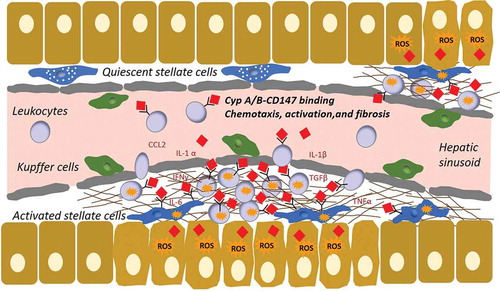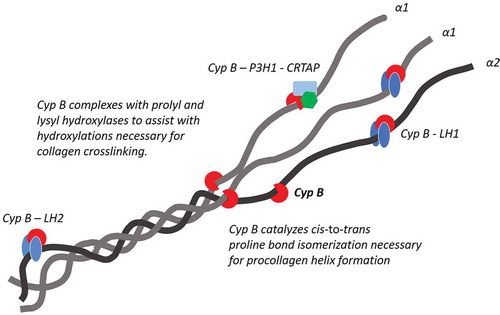Figures & data
Figure 1. Cyclophilin D regulates mitochondrial metabolism and integrity through binding to multiple mitochondrial proteins, including mitochondrial permeability transition pores (mPT). Cyclophilin D regulates glycolysis, β-oxidation, and ATP production through interactions with several key mitochondrial proteins. In pathological conditions Cyp D is recruited from the matrix to the inner mitochondrial membrane and promotes mPT in response to excessive matris calcium, ROS, and phosphate. Ion and metabolite flux through mPT pores in the inner mitochondrial membrane results in mitochondrial swelling, membrane rupture, and release of pro-apoptotic moleclues. Cell death ensures when mitochondrial injury or loss exceeds a thresold and can be blocked by cyclophilin D inhibition.

Table 1. Cyclophilin D molecular interactions.
Figure 2. Secreted cyclophilins A and B act as a pro-inflammatory cytokines. Cyco = lophilins A and B are secreted by hepatocytes in response to oxidative and other cellular stresses, Cyp A/B binding to the proinflammatory receptor, CD147, on monocytes, lymphocytes, and granulocytes promotes parenchymal infiltration and activation of inflammatory cells. Stimulation of CD147 on hepatic stellate cells promotes fibrosis.

Figure 3. Cyclophilin B controls collagen synthesis, Cyclophilin B, alone or in association with prolyl-3-hydroxylase 1 (P3H1) and cartilage associated protein (CRTAP), or with lysyl hydroxylases 1 or 2 (LH1, LH1) binds to proline residues in collagen alpha-chains during procollagen synthesis in the endoplasmic reticulum. Genetic deletion or inhibition of Cyp B results in decreases in prolyl and lysyl hydroxylations, procollagen cynthesis rates, mature collagen fibril density, and tensile strength of collagenous matrices.

